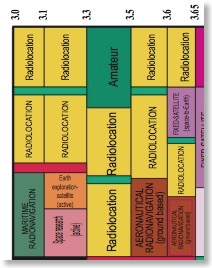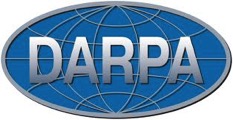DARPA Starts to Tackle Radar/Comm Sharing

When sharing was proposed, the same IRAC was able to dictate sharing conditions to FCC with the functioning of the radar as originally designed being the paramount issue. Overprotection that limited private sector sharing was of little concern to IRAC and the technical criteria development was often shrouded in secrecy to protect the technical details of the radars involved. This is shown in the case of the 5 GHz U-NII sharing where we have the bizarre sharing conditions of § 15. 407:
According to these 2 sections if an unlicensed device detects any signal on the channel greater than - 64 dBm (non techies: that is less than a millionth of a milliwatt!) it must avoid using that channel for the next 30 minutes! Double checking to see if it is a false alarm due to noise is not allowed by this rule.
§ 15.407(h)(2) Radar Detection Function of Dynamic Frequency Selection (DFS)
A channel that has been flagged as containing a radar system, either by a channel availability check or in-service monitoring, is subject to a non-occupancy period of at least 30 minutes. The non-occupancy period starts at the time when the radar system is detected..Radar Detection Function of Dynamic Frequency Selection (DFS). U-NII devices operating in the 5.25-5.35 GHz and 5.47-5.725 GHz bands shall employ a DFS radar detection mechanism to detect the presence of radar systems and to avoid co-channel operation with radar systems. The minimum DFS detection threshold for devices with a maximum e.i.r.p. of 200 mW to 1 W is −64 dBm. For devices that operate with less than 200 mW e.i.r.p. the minimum detection threshold is −62 dBm. The detection threshold is the received power averaged over 1 microsecond referenced to a 0 dBi antenna. The DFS process shall be required to provide a uniform spreading of the loading over all the available channels…Non-occupancy Period.
A channel that has been flagged as containing a radar system, either by a channel availability check or in-service monitoring, is subject to a non-occupancy period of at least 30 minutes. The non-occupancy period starts at the time when the radar system is detected.
(It is ironic that the recurring interference to NOAA’s TWDR weather radars is not addressed here since TDWR is a doppler system unlike FAA radars. It appears that DoD and FAA dominated the secret IRAC deliberations on the criteria that was dictated to FCC by NTIA and did not pay much attention to NOAA’s radar technology.)
To NTIA’s credit they did choose radar/communications sharing as the theme of the 2011 International Symposium on Advanced Radio Technologies, their annual public technical conference in Boulder CO. The conference was entitled “Developing Forward Thinking Rules and Processes to Fully Exploit Spectrum Resources: An Evaluation of Radar Spectrum Use and Management”. In the proceedings, is a paper (p. 214) from your blogger entitled “Thoughts on Radar/Communications Spectrum Sharing”. This paper breaks from the static precedent of U-NII radar sharing and suggested time dynamic sharing, noting that while 1000 ms/s spectrum access was essential when circuit switched voice dominated mobile traffic, today’s packet switched data is the dominant traffic and packet switching technology can readily make reliable networks our of time intermittent links.
The paper was discussed at the conference and here are two comments from the proceedings:
A second idea that is very important, first advocated for by Michael Marcus, is about unlicensed low power uses and it has spawned a revolution of technological developments that take advantage of that possibility. -- Phil Weiser, U. Colorado (Formerly senior advisor for technology and innovation to the National Economic Council at the White House)
I also wanted to take just a minute to recognize that Mike Marcus, who was originally going to be on this panel but couldn’t make it in the end, also put together a paper that talks about some sophisticated techniques for sharing with radars. -- Julius Knapp, FCC

The purpose of this conference is to provide information on the SSPARC program; promote additional discussion on this topic; address questions from potential proposers; provide a forum for potential proposers to present their capabilities for teaming opportunities; and following the conference, conduct pre-scheduled one-on- one meetings with the Program Manager as described below.
PROGRAM OBJECTIVE AND DESCRIPTION: DARPA anticipates releasing the BAA for SSPARC with the objective described in this section. The objective of the SSPARC program is to improve radar and communications capabilities through spectrum sharing. SSPARC develops technology applicable to spectrum sharing between military radars and military communications systems, and between military radars and commercial communications systems. SSPARC includes work on spectrum sharing systems and separation mechanisms, supporting technologies that improve performance when sharing spectrum, theoretical performance limits and grounded design techniques, and relevant regulatory topics.
It is gratifying to see that this concept is moving along towards more detailed study after being ignored for a long time.
Now if only the cellular industry would address the topic of using intermittent access to radar spectrum fro CMRS with an open mind rather than insisting on an unrealistic goal of meeting all their spectrum demands solely by reallocation.
UPDATE
The DARPA BAA is now posted here. From the introduction:
The Shared Spectrum Access for Radar and Communications (SSPARC) program seeks to improve radar and communications capabilities through spectrum sharing.
Spectrum congestion is a growing problem. It increasingly limits operational capabilities due to the increasing deployment and bandwidth of wireless communications, the use of net-centric and unmanned systems, and the need for increased flexibility in radar and communications spectrum to improve performance and to overcome sophisticated countermeasures. Radar and communications jointly consume most of the highly desirable spectrum below 6 GHz. SSPARC seeks to develop sharing technology that enables sufficient spectrum access within this desirable range for radar and communications systems to accomplish their evolving missions.
The SSPARC program seeks to support two types of spectrum sharing.
- Spectrum sharing between military radars and military communications systems (“military/military sharing”) increases both capabilities simultaneously when operating in congested and contested spectral environments.
- Spectrum sharing between military radars and commercial communications systems (“military/commercial sharing”) preserves radar capability while meeting national and international needs for increased commercial communications spectrum, without incurring the high cost of relocating radars to new frequency bands.
UPDATE 2/26/13
Today’s public meeting on the DARPA BAA was a great success with about 150 people present! There clearly is great interest in the topic in the R&D community.
Is there any interest in using such spectrum from the cellular establishment or will they continue their negative reaction to the PCAST report and demand 500 MHz of new spectrum subject to
- nationwide availability
- 24/7 1000 ms/s availability
- compliance with 3GPP band plans?
But as the PCAST report points out this is an unrealistic goal in a country with the largest most information intense military in the world. The cellular industry aimed too high in the “booster amplifier” rulemaking, Docket 10-4. Should they be more reasonable here?
UPDATE 3/15/13
 The SSPARC program now has the logo shown at left. It carefully does not show any physical system in order to be open minded about possible designed. DARPA has now posted on their website presentation from the Proposer’s Day. Of particular interest is a presentation from DoD spectrum managers showing how much spectrum is used by radar today.
The SSPARC program now has the logo shown at left. It carefully does not show any physical system in order to be open minded about possible designed. DARPA has now posted on their website presentation from the Proposer’s Day. Of particular interest is a presentation from DoD spectrum managers showing how much spectrum is used by radar today.


![Validate my RSS feed [Valid RSS]](valid-rss-rogers.png)

